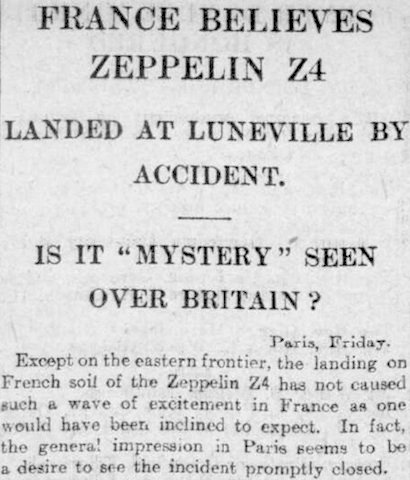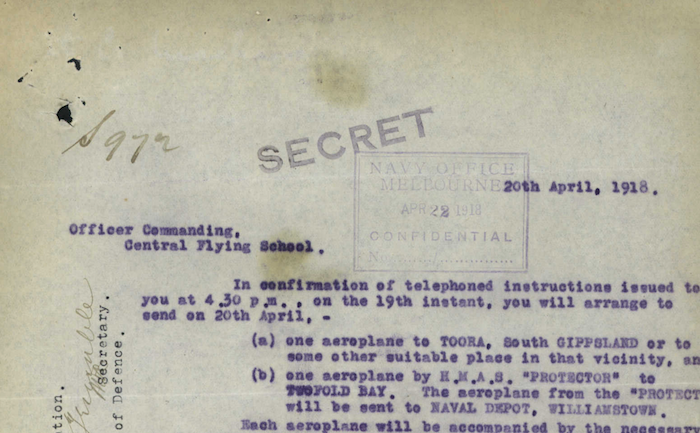The third leading article in today’s Economist is entitled ‘Airship fiascos and preliminary puffs’ (p. 868). It begins by casting back to ‘A FEW weeks ago, just before and after the Army and Navy Estimates were introduced’, when ‘a section of the Press was filled with lurid accounts of the danger in which Great Britain stood from the immensely powerful air fleet of Germany, and from our own unpreparedness’:
A very timely warning was found in the mysterious apparitions which hovered over quiet English fishing towns and villages by night, displaying bright lights. Evidently, said the alarmist Press, this was a German airship come over to spy out our secret defences, and the flesh of the public was for some days made to creep, until the mystery dissolved in a planet and a fire balloon. So the panicmongers were covered with ridicule, and the whole airship scare appeared to die down after Easter.
But now, ‘in the last few days […] we again have impressed upon us the “Peril of the Air,” and the menace which German airships constitute to our naval supremacy’. The Economist detects ‘a commercial background’ to all this, ‘as there was to “Daily Mail bread”‘:
for aught we know, the anonymous experts who clamour for public money may be acting in close association with airship company promoters. Certainly much of the stuff we read is exactly like the preliminary puffs that would be sent out if the circumstances are as our information suggests. In that case, Colonel Seely and Mr Churchill may well be cautious, remembering that the Marconi business was largely promoted as a great measure of Imperial defence.
It then goes on to undermine the claims being made for the awesome power of the airship, pointing out ‘it is never possible for long to exaggerate the power or reliability of any kind of air craft, for almost every day some accident occurs to prove how limited is man’s conquest of the air’. For example, only three weeks ago the new military Zeppelin Ersatz Z1 — ‘Curiously enough, this was the very airship which was supposed to have made the surreptitious trip to England, referred to above’ — broke in half on the ground, after being subjected to a strong wind for an hour.
The Z1 is said to be the sixteenth airship built by Count Zeppelin, and it appears that the majority of these have come to grief. At any rate, we now read that Germany has no more than seven vessels of this type, including the Z4, a vessel just completed, which was compelled last week to descend on French soil while on its trial trip.
Nor does there seem to be any great rate of advance in airship technology. One French expert, having had the benefit of having examined Z4 while it was temporarily disabled, says ‘that the first dirigibles constructed ten years ago have only been improved on in the way of more perfect detail or increased speed’:
The frame [of Z4], he says, is composed of elements indifferently employed at all points; it is uniform and still very heavy, the result being that this airship of 20,000 cubic metres’ capacity has only a lifting force available of 5,000 kilogrammes, or five tons. This expert also criticises the outer envelope, which is still loose over the greater part of the surface, and offers more resistance to the attainment of high speed than do non-rigid envelopes. As a matter of fact, this airship, says the same expert, which was reputed to be capable of travelling 50 miles an hour, has only accomplished 45⅝ miles as a maximum, and that irregularly.
The ‘usefulness of the airship, therefore, in time of war appears to be narrowly circumscribed, and the Economist accepts as ‘perfectly sound’ Seely’s explanation of why the Army is not buying large airships. (Though reproducing without comment his claim that the forthcoming Eta will be ‘an advance on anything which is known to be in the possession of any foreign Power’ is somewhat disingenuous, given that his evidence for this is that ‘It goes at great speed — 45 miles an hour’, a shade less than the 45⅝ miles per hour Z4 is criticised for ‘only’ reaching’.) Churchill, by contrast, has said that the Navy will ‘develop long-range airships of the largest type, but we cannot see that any large expenditure in this direction is necessary’:
Airships, it is true, have a longer radius of action than aeroplanes, but even now there are said to be aeroplanes in existence with a radius of 150 to 200 miles, and the radius is likely to be extended. The various types of hydro-aeroplanes, which have been evolved, some of which even carry guns and are fitted with wireless, with a range of 60 miles, and can rise or descend in comparatively rough waters, are, said Mr Churchill, ‘to put it modestly, certainly as good as anything which exists abroad.’ We cannot see why vessels on this type, carried on warships, should not become as effective for scouting purposes as the more expensive airship. (pp. 868-9)
Airships have the useful ability to hover over one spot, but as Seely has also pointed out, ‘great progress has been made in constructing aeroplanes that will fly both fast and slow; and it is possible that their power to hover will be still further developed in the near future’ (p. 869). Anyway, hovering aircraft will be singularly vulnerable to defensive fire. Turning to the aerial balance of power in both aeroplanes and airships:
In pinning their faith mainly to aeroplanes our War Office and Admiralty have followed the example of France, which, according to the Morning Post, possesses probably over 300 up-to-date aeroplanes, a number which will be increased within the next year by 150 or 200. Germany is believed to possess about 150 aeroplanes, while Great Britain by the end of the present financial year will probably possess nearly 300 aeroplanes in the hands of the War Office and Admiralty. The Navy has now 40 machines, and the Army 101. Of airships, Germany is believed to possess 24, of which 10 are privately owned; France 20, of which 5 are privately owned; Austria, 9, of which 2 are privately owned; Russia 11; Italy 7, of which 3 are privately owned; and Great Britain 4. Two further airships are to be added shortly, one of which, the ‘Astra Torres,’ is practically completed.
The Economist does not object to spending ‘a reasonable sum of money in the development of airships as well as aeroplanes, but the Military and Naval Estimates are already excessive’. Furthermore,
It is difficult to see how a hostile airship, even if it did fly over England, could do any considerable amount of damage before it was destroyed. Its only purpose is scouting, and here it possesses some advantage over the aeroplane in its radius of action, though the aeroplane is more wieldy and more speedy.
Hopefully, Churchill’s intimation that he might put forward a Supplementary Estimate for aircraft next week ‘does not signify that the Government is going to be humbugged by a series of cleverly devised panic puffs, which ought to deceive nobody’. In the end, the Economist is confident that ‘the public, which was amused by the airship scare, has not been in the least frightened by “our aeronautical correspondent.”‘
![]() This work is licensed under a Creative Commons Attribution-NonCommercial-NoDerivatives 4.0 International License.
Permissions beyond the scope of this license may be available at http://airminded.org/copyright/.
This work is licensed under a Creative Commons Attribution-NonCommercial-NoDerivatives 4.0 International License.
Permissions beyond the scope of this license may be available at http://airminded.org/copyright/.





